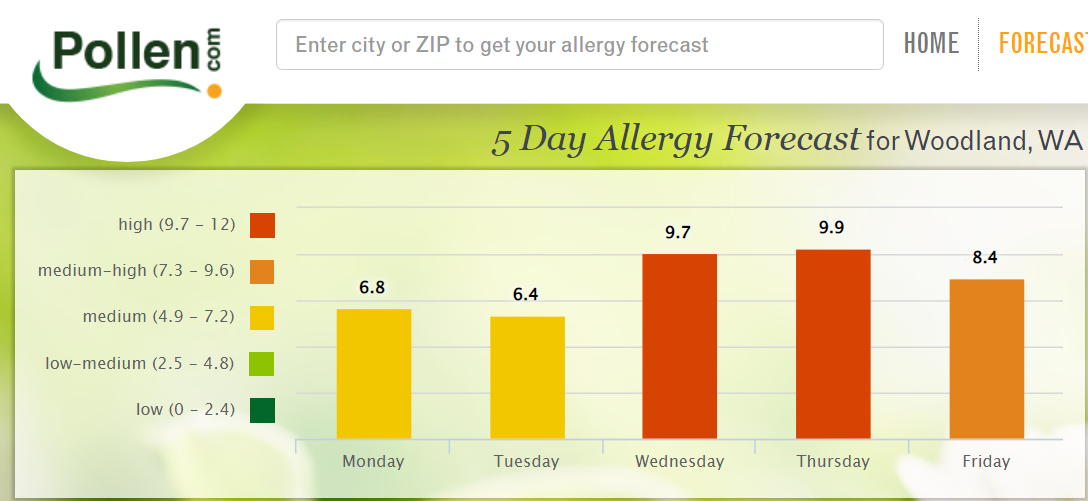I checked the forecast on Pollen.com. If you suffer from pollen allergies, it’s time to take action and start implementing your pollen prevention strategies. By mid-week, pollen counts will tip into the “high” levels. Taking control and implementing your prevention strategies now will pave the way to your healthier, happier life. If you want a recap of how you can say goodbye to allergies and reduce allergy symptoms by expanding your holistic journey toward optimal health and vitality, here it is.
Integrating Natural Remedies
 Natural remedies for allergies offer a range of benefits that make them an attractive option for individuals seeking alternative approaches to manage their symptoms. Firstly, natural remedies often have fewer side effects compared to conventional medications, providing relief without unwanted reactions. They also take a holistic approach by addressing the underlying imbalances in the body, supporting long-term relief rather than just suppressing symptoms. Natural remedies can be personalized to suit individual needs, offering various options such as nutritional supplements, herbal supplements, essential oils, and dietary changes. Here are 5 nutritional supplements you can find online to help reduce your allergy symptoms.
Natural remedies for allergies offer a range of benefits that make them an attractive option for individuals seeking alternative approaches to manage their symptoms. Firstly, natural remedies often have fewer side effects compared to conventional medications, providing relief without unwanted reactions. They also take a holistic approach by addressing the underlying imbalances in the body, supporting long-term relief rather than just suppressing symptoms. Natural remedies can be personalized to suit individual needs, offering various options such as nutritional supplements, herbal supplements, essential oils, and dietary changes. Here are 5 nutritional supplements you can find online to help reduce your allergy symptoms.
If you are a client who has come in for allergies in the past, you might be familiar with the formula with the blue label. That’s your formula for allergies, and because herbal formulas need time to load into your system, try starting it on Monday. The benefit of integrating Chinese Herbal formulas into your allergy management plan is the gentle, personalized approach herbs take to improving the underlying imbalances in your body.
Reducing Pollen Counts in Your Home
Because pollen plays a significant role in triggering allergies and causing discomfort for many individuals, reducing pollen counts in your home can create a safer, more comfortable environment for you. What are some of the strategies you can take to help reduce pollen in your home?
 Trees, grass, and flowers release pollen into the air that can quickly enter your respiratory system. Improving indoor air quality can be the decisive step to creating a healthier and more comfortable living environment. There are several effective strategies you can implement to achieve this goal. First, proper ventilation is key. When pollen counts are low, help your home’s airflow by opening windows or using exhaust fans in kitchens and bathrooms to remove pollutants. If you’re looking for a low cost, effective solution then check out my simple DIY air purifier. When pollen counts start to climb, keep those windows and doors closed. High-efficiency particulate air (HEPA) filters in air purifiers and HVAC systems can effectively capture and remove airborne particles. I’ve tried ALOT of HEPA air purifiers and this one is still one of my favorites. Additionally, reducing chemical-based cleaning products and opting for natural alternatives can help minimize the release of pollutants into your environment.
Trees, grass, and flowers release pollen into the air that can quickly enter your respiratory system. Improving indoor air quality can be the decisive step to creating a healthier and more comfortable living environment. There are several effective strategies you can implement to achieve this goal. First, proper ventilation is key. When pollen counts are low, help your home’s airflow by opening windows or using exhaust fans in kitchens and bathrooms to remove pollutants. If you’re looking for a low cost, effective solution then check out my simple DIY air purifier. When pollen counts start to climb, keep those windows and doors closed. High-efficiency particulate air (HEPA) filters in air purifiers and HVAC systems can effectively capture and remove airborne particles. I’ve tried ALOT of HEPA air purifiers and this one is still one of my favorites. Additionally, reducing chemical-based cleaning products and opting for natural alternatives can help minimize the release of pollutants into your environment.
Regular cleaning and dusting of surfaces, including floors, furniture, and shelves, will help minimize the presence of settled pollen. Using a vacuum cleaner with specific features can be highly beneficial for pollen removal. Look for a vacuum cleaner with a high-efficiency particulate air (HEPA) filter. HEPA filters are designed to capture tiny particles, including pollen, effectively. They can trap up to 99.97% of particles as small as 0.3 microns in size, ensuring that the pollen is not released back into the air while you clean. Additionally, choose a vacuum cleaner with strong suction power and a sealed system to prevent pollen from escaping through cracks or gaps in the vacuum. Consider a model that includes attachments and accessories such as a crevice tool and upholstery brush to clean various surfaces where pollen may accumulate effectively. Regularly cleaning your home with a HEPA-filtered vacuum will help minimize the presence of pollen, providing a cleaner and allergen-free environment.
Everyone loves the smell of clothes allowed to be wind-swept dried. Yet, laundry hanging outdoors can easily capture pollen that attaches to the fabric. For this season, think about drying your clothes indoors. Lastly, consider creating a designated area near the entrance where you can remove your shoes and outerwear to prevent tracking pollen throughout the house.
Conclusion
Creating a pollen prevention strategy offers you numerous benefits. By implementing preventive measures, you can minimize the frequency and severity of allergy symptoms, such as sneezing, nasal congestion, itchy eyes, and coughing. A pollen prevention strategy also improves the overall quality of life by providing relief and allowing you to engage in outdoor activities without constant discomfort. Additionally, reducing pollen exposure can contribute to better sleep quality and overall respiratory health. By creating a comprehensive plan, you can enjoy a more symptom-free lifestyle.

